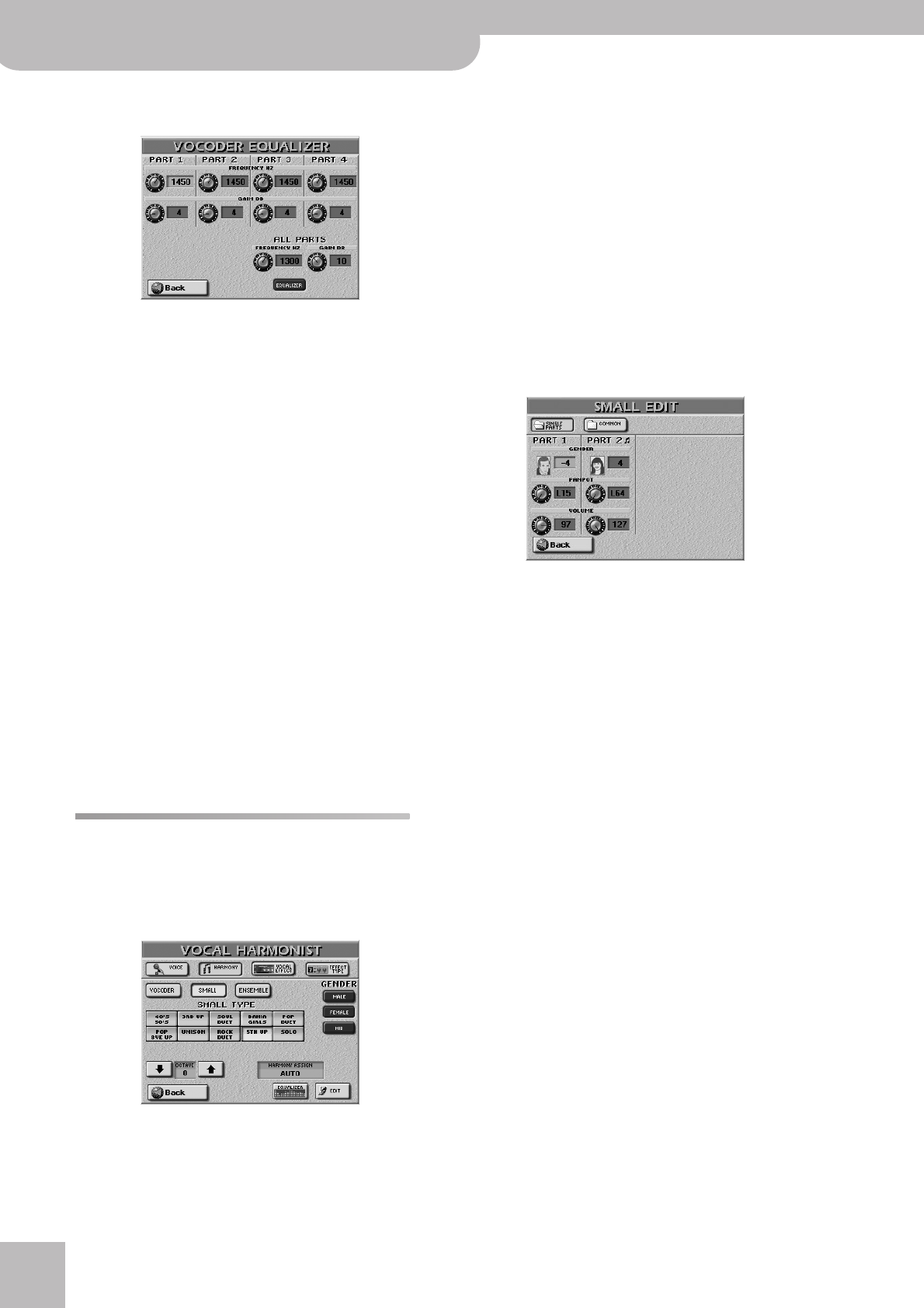
Editing the Vocal Harmonist parts
154
r
E-80 Music Workstation
If you press the
[EQUALIZER]
field…
…the display looks as follows:
This page contains a simple equalizer for each
Vocoder part, as well as an EQ band that applies to all
four voices simultaneously, for added flexibility.
These are connected in series.
• Press the field of the parameter you want to edit and
set the desired value with the [DATA÷ENTRY] dial or
the [DEC]/[INC] buttons.
● EQUALIZER—Press this field to switch all equalizers on
this page on or off. The equalizer can be used for two
things: (a) emphasizing a specific frequency range to
create a special effect or make the part more distin-
guishable; (b) to reduce the level of frequencies that
mask other sounds or produce a “boomy” sound.
● FREQUENCY HZ—Use this parameter to select the fre-
quency whose level you wish to change with the GAIN
parameter. The smaller the value, the lower the fre-
quency that will be boosted or cut. The ALL PARTS FRE-
QUENCY HZ parameter affects the sound of all four parts
(1~4).
● GAIN dB—This parameter sets the level of the selected
frequency. “0” means that the frequency’s level does not
change (no difference between equalizer on and off). The
ALL PARTS GAIN dB parameter affects the sound of all
four parts (1~4).
• Press the [BACK] field to leave this page.
Small settings
When the [SMALL] indicator lights, two-part harmonies
are added to your singing. Press and hold the button to
select the following page where you can specify what
kinds of voices will be used for these harmonies.
(1) Press and hold the [SMALL] button.
(2) In the GENDER column (right), press the field that
corresponds to the kind of choir you want to add
to your singing.
Press [MALE] for a man’s choir or [FEMALE] for female
voices. Press [MIX] to create a mixed choir. The field
you press here determines what presets are available.
The preset sets the number of voices (1 or 2) that will
be added.
Note: For an optimum effect, be sure to set the GENDER VOICE
INPUT parameter to match your voice type. See page 150.
(3) Set the desired “HARMONY ASSIGN” value with the
[DATA÷ENTRY] dial or the [DEC]/[INC] buttons.
See “Who specifies the harmonies?” on p. 48.
● OCTAVE (–1~1)—This parameter allows you to transpose
the harmony voices one octave up or down. Use it if you
think the arrangement becomes a bit “cluttered” or to
achieve a special effect.
If you press the
[EDIT]
field…
(Press the [SINGLE¥PARTS] field to select this page.)
The lowest note played by the selected song part or
yourself is assigned to “Part 1”, while the second is
assigned to “Part 2”.
• Press the field of the parameter you want to edit and
set the desired value with the [DATA÷ENTRY] dial or
the [DEC]/[INC] buttons.
● GENDER—Allows you to change the timbre of the part.
Negative values produce a “masculine” effect, positive
values add “feminine” qualities. This parameter should be
set in relation to the COARSE value (if you want to
achieve a realistic effect).
● PANPOT—Allows you to set the placement of the corre-
sponding part in the stereo sound image. This is only
meaningful if you connect the E-80 to a stereo amplifier.
“L64” corresponds to hard left, “0” to dead center and
“R63” to hard right.
● VOLUME—Allows you to set the level of the correspond-
ing part. Be aware that even the highest value produces
no audible effect if the [HARMONY] knob is set all the
way to “OFF”.
